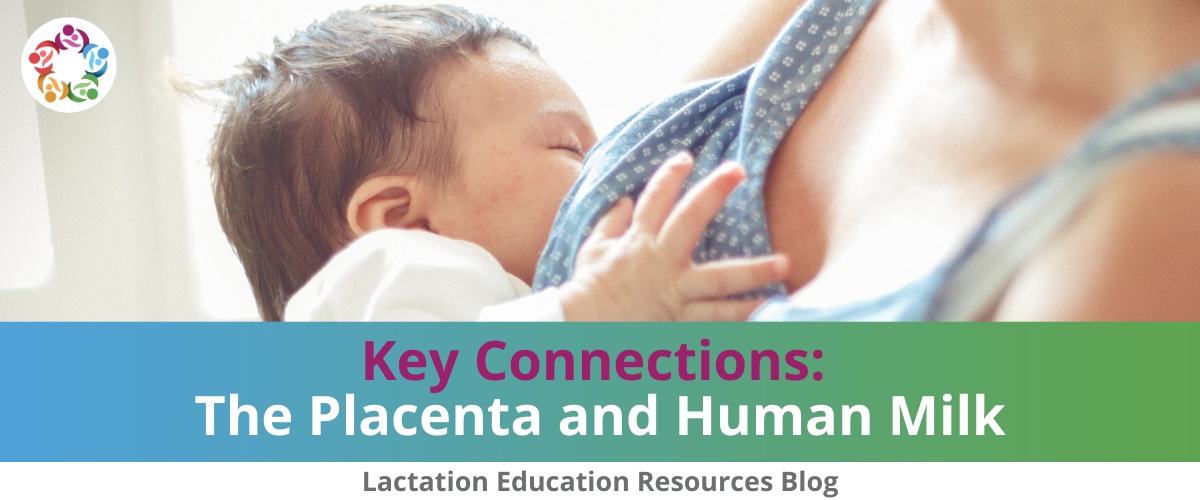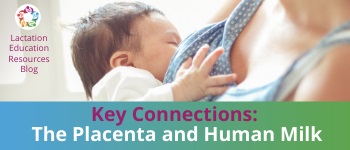Key Connections: The Placenta and Human Milk

Pop quiz: We know you love and respect human milk. But can you name the biological entity that is the most
like human milk?
If you didn’t say, “The placenta, of course!” it’s not surprising.
Although it has a huge and important role in the lifelong health of both infant and parent, the placenta is one of the most dismissed pieces of the gestation-birth-lactation puzzle.
But the placenta is amazing, and in fact, it’s intimately connected to human milk! In many ways, the placenta and human milk act as members of a relay team: The placenta provides key functions during pregnancy, and then passes the baton to human milk to carry on the work.
And just like human milk, the placenta is much more than simply a means of nutrition.
In the final webinar in her Lactation Education Resources conference series “Human Milk: Leaps Beyond Nutrition,” Laurel Wilson spells out the evolutionary and scientific links between human milk and the placenta.
Read on for five key connections between the placenta and human milk—and give good reasons to give the placenta the respect it deserves.
Connection 1: Both seed the microbiome Science is uncovering more and more ways our microbiome determines lifelong health. But did you know it all starts with the placenta?
We used to think the womb was a sterile environment, but newer evidence has shown that the first seeding and feeding of the baby’s microbiome occurs in utero, with the placenta as the delivery vehicle.
Via the placenta, the baby receives the parent’s microorganisms—interestingly, primarily the ones present in the parent’s mouth and throat.
After this first seeding, the baby’s microbiome gets another boost during birth, when they pick up the microorganisms present in and around the vaginal canal. Then, they ingest more microorganisms as they begin to lick and touch the parent’s skin.
Finally, human milk takes over the job of transferring the parental microbiome, as the baby continues to ingest bacteria unique to their family, along with human milk oligosaccharides, designed for no other purpose than to nourish the microbiome.
Together, the placenta and human milk, function to create a microbiome for the baby as unique as a fingerprint, according to Wilson, that reflects where the baby lives geographically in the world as well as the particular family they were born into.
Connection 2: Both turn genes on and off Both the placenta and human milk also play roles in keying gene expression, which sets the stage for lifelong health outcomes. This process is known as epigenetics.
The placenta, and later the milk, deliver information from the environment to help design a body and brain that will function best in the environment it is born into, by switching genes on or off.
“The maternal body prepares the baby for [its] environment first via the placenta, then with human milk,” Wilson explains. “These organs are thus creating a super baby that can thrive in the world it’s born into.”
Connection 3: Both transfer immunity The placenta and human milk are key in providing the baby with immune factors—another job they share. During pregnancy, the placenta transfers IgG from the mother to provide immune protection. Once the baby is born and the cord is cut, this protection ends.
This begins a brief period of immune stress, during which bilirubin plays a key role by acting as an antioxidant.
Once the baby begins breast- or chest feeding, colostrum and human milk take over, providing secretory IgA. The baby begins to conjugate and flush bilirubin, and eventually, to create its own immune factors.
“This ability … takes time, and initially the placenta and human milk are performing this function for the baby,” Wilson says. “Take note that infant formula cannot in any way, shape, or form provide this function.”
Connection 4: Both provide hormones Another similarity between the placenta and human milk? Both provide key hormones.
During pregnancy, the placenta creates and releases human chorionic gonadotropin (HCG), human placental lactogen (HPL), and cortico-releasing hormones, along with progesterone and estrogen—in fact, by the end of pregnancy, the placenta is making more of these hormones than the parent’s body!
These hormones not only develop the baby and sustain the pregnancy—they also assist with the development of mammary tissue and prep the parental brain for the behaviors of bonding.
Once the baby is born, milk takes over the job of providing hormones—especially oxytocin, the “love hormone,” which promotes bonding and brain development.
Leptin and adiponectin are also delivered via human milk, influencing growth rate, energy processing, and lifetime risk of obesity.
And glucocorticoids in human milk shape the emotional hub in the baby’s brain, contributing to lifelong variables like impulsivity, aggression, shyness, and extroversion.
Connection 5: Both provide nutrients Of course, the most obvious role shared by placenta and human milk can’t be dismissed-- both nourish the baby.
The placenta provides macro- and micronutrients, sending seven grams of fat every day to the developing baby, which is deposited into the growing brain for rapid growth over the next three years.
And consistent with its role as a star on the relay team, the placenta also works throughout pregnancy to develop the mammary gland … so that it can pass the job of nourishing the baby on to its heroic teammate—human milk … which, just like the placenta, provides nutrition along with so much more.
Ready to learn more? Enroll in Wilson’s conference through Lactation Education Resources here.

Pop quiz: We know you love and respect human milk. But can you name the biological entity that is the most
like human milk?
If you didn’t say, “The placenta, of course!” it’s not surprising.
Although it has a huge and important role in the lifelong health of both infant and parent, the placenta is one of the most dismissed pieces of the gestation-birth-lactation puzzle.
But the placenta is amazing, and in fact, it’s intimately connected to human milk! In many ways, the placenta and human milk act as members of a relay team: The placenta provides key functions during pregnancy, and then passes the baton to human milk to carry on the work.
And just like human milk, the placenta is much more than simply a means of nutrition.
In the final webinar in her Lactation Education Resources conference series “Human Milk: Leaps Beyond Nutrition,” Laurel Wilson spells out the evolutionary and scientific links between human milk and the placenta.
Read on for five key connections between the placenta and human milk—and give good reasons to give the placenta the respect it deserves.
Connection 1: Both seed the microbiome Science is uncovering more and more ways our microbiome determines lifelong health. But did you know it all starts with the placenta?
We used to think the womb was a sterile environment, but newer evidence has shown that the first seeding and feeding of the baby’s microbiome occurs in utero, with the placenta as the delivery vehicle.
Via the placenta, the baby receives the parent’s microorganisms—interestingly, primarily the ones present in the parent’s mouth and throat.
After this first seeding, the baby’s microbiome gets another boost during birth, when they pick up the microorganisms present in and around the vaginal canal. Then, they ingest more microorganisms as they begin to lick and touch the parent’s skin.
Finally, human milk takes over the job of transferring the parental microbiome, as the baby continues to ingest bacteria unique to their family, along with human milk oligosaccharides, designed for no other purpose than to nourish the microbiome.
Together, the placenta and human milk, function to create a microbiome for the baby as unique as a fingerprint, according to Wilson, that reflects where the baby lives geographically in the world as well as the particular family they were born into.
Connection 2: Both turn genes on and off Both the placenta and human milk also play roles in keying gene expression, which sets the stage for lifelong health outcomes. This process is known as epigenetics.
The placenta, and later the milk, deliver information from the environment to help design a body and brain that will function best in the environment it is born into, by switching genes on or off.
“The maternal body prepares the baby for [its] environment first via the placenta, then with human milk,” Wilson explains. “These organs are thus creating a super baby that can thrive in the world it’s born into.”
Connection 3: Both transfer immunity The placenta and human milk are key in providing the baby with immune factors—another job they share. During pregnancy, the placenta transfers IgG from the mother to provide immune protection. Once the baby is born and the cord is cut, this protection ends.
This begins a brief period of immune stress, during which bilirubin plays a key role by acting as an antioxidant.
Once the baby begins breast- or chest feeding, colostrum and human milk take over, providing secretory IgA. The baby begins to conjugate and flush bilirubin, and eventually, to create its own immune factors.
“This ability … takes time, and initially the placenta and human milk are performing this function for the baby,” Wilson says. “Take note that infant formula cannot in any way, shape, or form provide this function.”
Connection 4: Both provide hormones Another similarity between the placenta and human milk? Both provide key hormones.
During pregnancy, the placenta creates and releases human chorionic gonadotropin (HCG), human placental lactogen (HPL), and cortico-releasing hormones, along with progesterone and estrogen—in fact, by the end of pregnancy, the placenta is making more of these hormones than the parent’s body!
These hormones not only develop the baby and sustain the pregnancy—they also assist with the development of mammary tissue and prep the parental brain for the behaviors of bonding.
Once the baby is born, milk takes over the job of providing hormones—especially oxytocin, the “love hormone,” which promotes bonding and brain development.
Leptin and adiponectin are also delivered via human milk, influencing growth rate, energy processing, and lifetime risk of obesity.
And glucocorticoids in human milk shape the emotional hub in the baby’s brain, contributing to lifelong variables like impulsivity, aggression, shyness, and extroversion.
Connection 5: Both provide nutrients Of course, the most obvious role shared by placenta and human milk can’t be dismissed-- both nourish the baby.
The placenta provides macro- and micronutrients, sending seven grams of fat every day to the developing baby, which is deposited into the growing brain for rapid growth over the next three years.
And consistent with its role as a star on the relay team, the placenta also works throughout pregnancy to develop the mammary gland … so that it can pass the job of nourishing the baby on to its heroic teammate—human milk … which, just like the placenta, provides nutrition along with so much more.
Ready to learn more? Enroll in Wilson’s conference through Lactation Education Resources here.
By accepting you will be accessing a service provided by a third-party external to https://www.lactationtraining.com/
